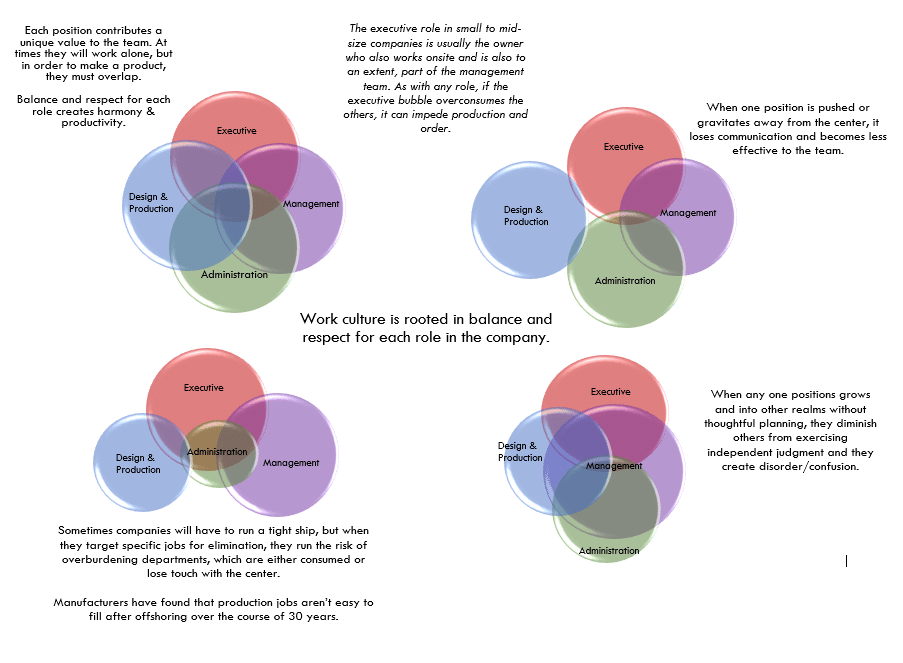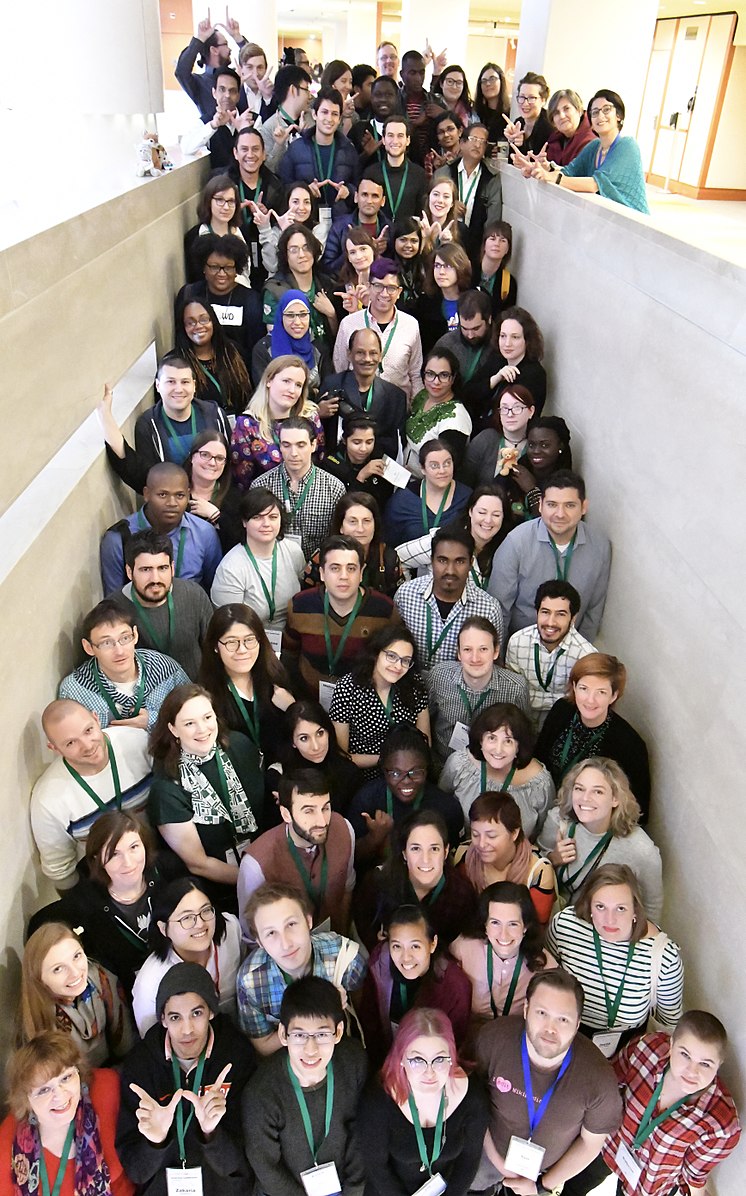Work Culture in 21st Century Manufacturing
By Aimee Sukol, JD/MA/MS Ed.
Introduction
Manufacturing’s share of US employment is approximately 8% down from 32% in the 1940’s in part to trade/outsourcing and to technologies that enabled productivity to outpace employment. Thus, as large OEM’s moved overseas, domestic producers comprised smaller, contract manufacturing firms where most factory workers are employed. For example, the Bureau of Labor & Statistics cites 22.5% of factory workers are employed by companies with 50 or fewer employees versus 16.6% of factory workers are employed by companies with 1000+ employees. In fact 98.6% of US manufacturing companies are small businesses and 75.3% of those companies employ less than 20 workers.
In the past ten years overseas production costs have increased, motivating OEM’s to add their domestic production and seek domestic suppliers. The increased demand on domestic production has added a new emphasis on hiring within the traded sectors, such as sheet metal fabrication.
 The above tells us a few things:
The above tells us a few things:
- Over 30 years, the US saw a significant loss in manufacturing jobs that drove new worker generations to other industries.
- Overseas production costs eventually inspired a new demand for domestic production.
- Small businesses drive the US manufacturing workforce.
These trends in manufacturing have left small businesses scrambling to address supply chain fluctuations with a smaller, changing workforce. And while demand throughout the supply chain from OEMs to Tier 3 suppliers for a domestic workforce increased, marginal emphasis has been placed on how to develop and retain a manufacturing workforce. As I’ve pointed out in other articles, resources have focused primarily on vetting non-college bound youngsters rather than how to design work cultures younger generations can appreciate.
This article focuses on the importance of work culture to manufacturers and how the manufacturing industry can use workplace culture to recruit workers & bolster operations.
What is Work Culture?
 “Work Culture” in this article is defined as the environment and managerial philosophy that establish job satisfaction, co-worker cooperation, and staff retention. I conducted a survey and asked people which of the following impacts work culture most:
“Work Culture” in this article is defined as the environment and managerial philosophy that establish job satisfaction, co-worker cooperation, and staff retention. I conducted a survey and asked people which of the following impacts work culture most:
- Tone of respect
- Reasonableness of workload
- Compensation
- Decision-making control
72% of respondents stated that “tone of respect” impacted work culture most.
So what is a tone of respect?
 Some could argue that a workplace with a general sense of respect includes fairness e.g., no favoritism, clear communication, constructive feedback, and to a degree incorporates reasonableness of workload, compensation, and workplace input.
Some could argue that a workplace with a general sense of respect includes fairness e.g., no favoritism, clear communication, constructive feedback, and to a degree incorporates reasonableness of workload, compensation, and workplace input.
Each year Meta Fab distributes Oregon Business’ employee satisfaction survey to gauge workers’ interests and priorities, and through this survey we learn that communication is most important. When broken down into subcategories, we understand that employees want to know management’s expectations and rationale behind decisions. In 2020, Meta Fab held a two-month management training program so managers could identify their priorities and through consensus, build communication plans that served each other across management (production, welding, shipping, engineering, quality control, powder coating/machining) and within their teams.
The absence of a planned work culture is a serious challenge. Frequently, employers focus their mission and sense of purpose entirely on service delivery to their customers and forget to evaluate their commitment to their employees. Resentment that develops when employees feel like servants rather than respected team members becomes its own work culture, albeit a negative and destructive one.
Work Culture in Manufacturing
Manufacturers face specific challenges that make work culture particularly important. First, manufacturing often involves rote and repetitive work that may not stimulate workers’ passions or interests. Second, factories are not particularly charming or warm spaces. Third, manufacturing involves expensive and potentially dangerous equipment that requires strict rules and procedures. Last, quality production demands timeliness, rigid scheduling, and workers’ ability/willingness to identify mistakes or problems.
The irony in manufacturing is that the industry’s unique nature calls for a well planned work culture to avoid mistakes, injury, and disruptions to production, yet manufacturers are often least likely to place emphasis on the work environment’s character. Failure to invest in work culture is among key reasons why manufacturers struggle to source 21st century workers.
Work culture more than many other industries impacts manufacturers’ bottom line so it’s vital that manufacturers invest in their employees’ workplace satisfaction.
How to Identify a Toxic Work Environment?
 What are signs that a work environment is toxic?
What are signs that a work environment is toxic?
- High turnover
- Complaints from employees
- Complaints from customers
- Co-worker arguments
- Poor work performance, complacency
- Worker fear or reluctance to communicate
- High rates of tardiness or calling out
- Blame game/lack of accountability
It’s not uncommon for employers to experience the above phenomena and assume it’s an individual employee issue or caused by a few bad apples, but these issues arise for a number of reasons including:
- Unplanned hiring/mismatched skills criteria
- Lack of communication
- Unrealistic expectations
- Lack of support/resources
- Lack of trust
Problems in the workplace start at the top. The distinct nature of leadership is practicing stated values and accepting responsibility for behavior and performance under one’s command. Thus, it’s imperative for employers to not only recognize issues, but to identify how the workplace, processes, and leadership decisions cause and contribute to toxic work cultures. Questions to consider when evaluating a remedy to a toxic work culture:
- Does HR need more guidance on qualifications?
- Does the employer provide adequate training and onboarding?
- Does leadership demonstrate conduct it expects from workers?
- Are rules and procedures accessible and easy to understand, e.g., is information provided in writing, visually and verbally?
- Does the employer ask for worker feedback? How often? Is feedback implemented?
- Does the employer show an interest in employees’ well being?
- Are workers rewarded or recognized for positive performance?
- Are workers singled out for mistakes?
- Does leadership take responsibility for mistakes?
- Does leadership use a punitive model for addressing issues?
The above questions should provide guidance for developing a positive work culture.
How to Create Work Culture?
 First, it’s important to emphasize the fact that trust is a significant component of respect. Trust is often eroded when employers fail to clearly explain decisions even if doing so is with the best intentions. Therefore, building a positive work culture requires transparency to maintain and protect a trusting relationship between employers and staff.
First, it’s important to emphasize the fact that trust is a significant component of respect. Trust is often eroded when employers fail to clearly explain decisions even if doing so is with the best intentions. Therefore, building a positive work culture requires transparency to maintain and protect a trusting relationship between employers and staff.
Second, don’t wait too long before establishing a thoughtful work culture. It is far easier to develop a positive work culture when workers are already feeling positive or at least neutral. If/when a sense of toxicity develops among staff, development of a positive work culture must overcome existing discord and distrust. Employees may not believe a work culture plan is sincere or perhaps management and staff are at such odds that employers need to reconsider roles and responsibilities. Thus, a proactive approach to the workplace is ideal.
Third, employers should seek worker input and can use Survey Monkey or Oregon Business’ employee satisfaction survey as anonymous methods for collecting feedback. Furthermore, when workers don’t see their input implemented they will be less likely to participate in future surveys and they’re likely to develop even deeper feelings of contempt; therefore, employers should expect to begin an action plan and follow up with workers after surveys are completed.
Above all, employers should embrace all feedback for consideration, rather than expect workers to provide answers that purely benefit the employer. For example, an employer once asked me what I wanted to see from my job and reacted negatively when I said, “Higher compensation”. Wanting to be paid more is a key issue for many workers and employers who dismiss this concern fail to understand the fundamental relationship between employer and employee. Thus, whether an employee seeks more money, resources, or time, that feedback is an opportunity for the employer to address an issue before it forms workplace character/energy.
Conclusion
 Workplace culture is the environment an employer creates and maintains through expectations, communication, processes, tone, recognition, and problem resolution. This is a top/down responsibility so if a workplace has become toxic, leadership has failed – full stop.
Workplace culture is the environment an employer creates and maintains through expectations, communication, processes, tone, recognition, and problem resolution. This is a top/down responsibility so if a workplace has become toxic, leadership has failed – full stop.
Furthermore, work culture should not require job candidates/workers to share a personality type or as some call it, “right fit”. Seeking the “right fit” can and frequently does exclude candidates or marginalize workers with disabilities especially neurodivergent people (Autism, ADHD, Cerebral Palsy, Aspergers, etc) and those with mental illness (Depression, Anxiety, etc). Thus, the goal of designing a work culture is not to exclude certain types of people or to create a club of like-minded teams, but rather to ensure a healthy and efficient workplace of people with diverse abilities and personalities.
Feel free to contact me for more information about designing a work culture at aimee@metafab.com and if you’d like to discuss sheet metal fabrication or a project, don’t hesitate to contact tony@metafab.com.